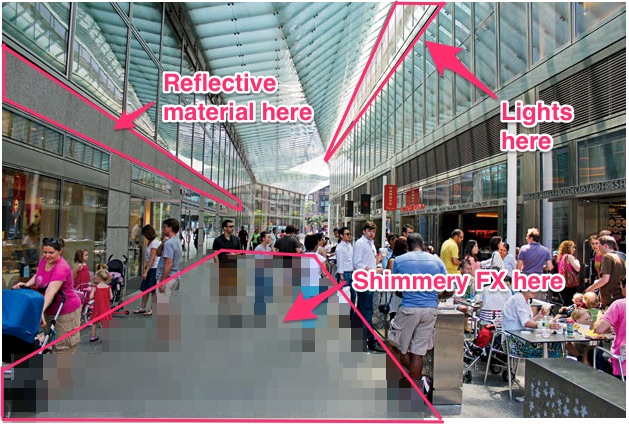Reiteration of our goals:
Encourage contemplation of nature in an indoor/outdoor urban space by amplifying the presence of nature in the space. Bring more personality to the space via elements of intrigue and interaction. Transform the space to be more welcoming at night.
Our experiment this week:
Our next steps last week were to understand how the effects might work in the space itself and identify the environmental factors (natural light and wind) that will affect the product at night.
We went to North End Way with a medium size sheet of Mylar (approx 6′ x 3′) and a flash light (500 lumens). We learned that there are multiple locations that light can reflect to cause different unique effects; it can reflect off the brick walls on both sides of the building and on the glass windows behind the seats when the shades are pulled down. It can reflect on the walls as well as the floor. The light that is in the space isn’t too overpowering and allows our light source to reflect a large amount of area. The more material we have and the brighter the lights the more space we can cover.
The space is much quieter and darker at night. It’s actually somewhat eerie to walk through the long, quiet corridor. As such, we believe there’s an opportunity to make it more attractive and interactive. Through our experiments we also found that the shimmering light enhances the surroundings by playing with the wind and provide a source of intrigue. Since evening hours are less busy, people have more time to stop and interact with the installation.
Passers-by certainly seemed intrigued, and we’ve had no trouble with security yet!
Using the space:
We’re focusing on two options, one at each end of the passageway.


Next:
For our next ideation we can discuss through our findings at the space how we want to play with interactions with light. We can test this by setting up a structure in the studio that uses multiple IR sensors connected to multiple lights and as people walk through the studio and pass our space the light that reflects off the material will change. Our device will also be placed near a window to use the wind for naturalistic light effects.
We can test this with both the old material and the new more reflective material. Does being more reflective and more mirror like cause people to want to come up to the device? The higher order thing here is to play with switching between the regular / predicable and the irregular / unpredictable? That could be the mirror concept, or having motion affect the light source – which seems to be the stronger and likely more effective idea at this point. But how we achieve it is unknown – do we want a strip of LEDs, or a moving light, or a stationary light that rotates?



This looks really beautiful!
I like the second proposed setup, I question what the shimmer will look like on glass as shown on the first setup. A strip of LEDs will give a very different look compared to a single source. I would like to know more about the user interaction, why would a light move vs .the reflective surface moving? How is this connected to the environment? I think it is worthwhile thinking about pairing this with something that is a much more explicit depiction of data or a location at which people can dig deeper into specifics.
Nice work!
-Michael